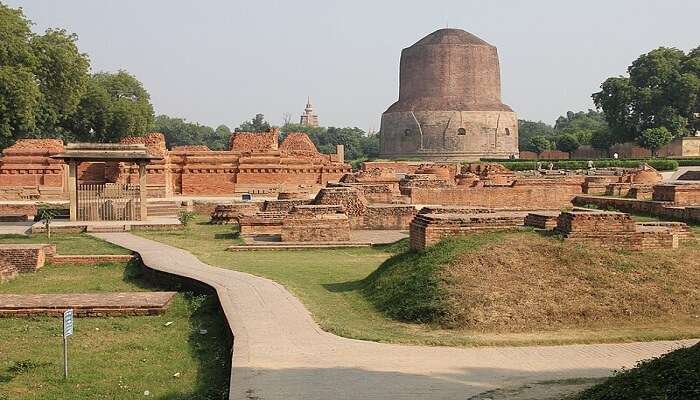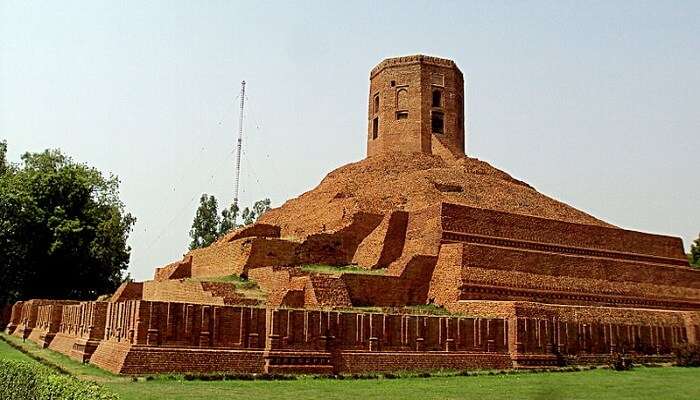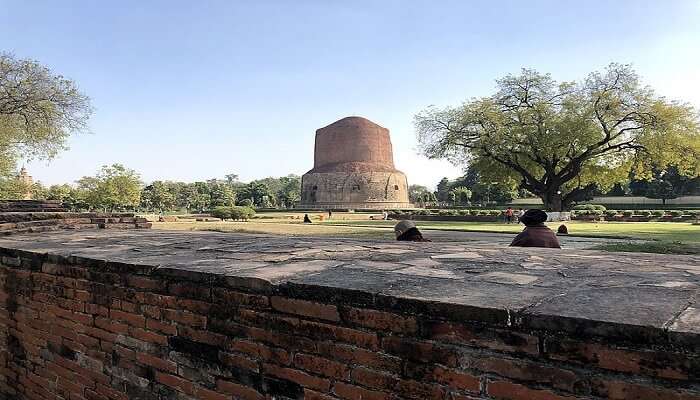Visit Dhamek Stupa In Sarnath For A Spiritual Gateway In 2025

Located in Sarnath, Dhamek Stupa in Uttar Pradesh is where Gautam Buddha is said to have held his first dialogue with his first five disciples. Moreover, it is also the site where the five found liberation, thus leading to the formation of the sangha. The word Dhamek translates to “pondering the law” in Sanskrit. This structure is the biggest one at the archaeological site of Sarnath and is in the shape of a cylinder with the walls featuring a number of intricately carved human and animal figures as well as text.
About Dhamek Stupa

Dhamel Stupa at Uttar Pradesh’s archaeological site of Sarnath was built sometime between the 5th and 6th century AD and is said to stand on the very spot where Gautam Buddha supposedly shared his first discourse with his first five disciples who were Bhaddiya, Mahanama, Kaundinya, Vappa and Assaji. It is believed that they attained liberation here and therefore led to the sangha’s formation. The stupa’s name comes from the Sanskrit word dharmeksā which translates to “pondering the law.” It happens to be the biggest building in Sarnath, standing tall at about 4 metres and is in the shape of a cylinder. The structure is made out of bricks and stone; its the lower part of the stupa dates back to Ashoka the Great of the Mauryan Empire while the other part seems to date back to the Gupta period. The walls have beautiful carvings of human and animal figures, flowers, and inscriptions in the Brahmi script.
Dhamek Stupa has undergone construction for its enlargement 6 times but the upper part still remains unfinished. According to archaeologists, it is probable that the stupa’s expansion was ordered by Ashoka but there is evidence to suggest that the structure that stands today dates back to the Gupta period. It is also believed that Dhamek Stupa is one of the eight stupas under which lay Buddha’s ashes following his parinirvana.
Several archaeologists, both Indian and international, have excavated the site. Moreover, close to the stupa lies an Ashoka pillar with a lion capital.
Must Read: Things To Do In Sarnath
Sarnath And Its Importance In Buddhism

Sarnath, an archaeological site in Uttar Pradesh, is close to the Ganges and Varuna rivers. It is one of the most important sites in the world when it comes to Buddhism as it is believed to be where Gautam Buddha delivered his first sermon following his enlightenment and also where the sangha was formed owing to the enlightenment of his five disciples. Its name, which means “Lord of the Deer,” comes from the Sanskrit word Sāranganātha; according to a Buddhist legend, the Bodhisattva was a deer who offered its life in the place of a doe that was to be killed by a king. Gautam Buddha is said to have deemed Sarnath as one of the four pilgrimage sites that Buddhists must visit, alongside Bodh Gaya, Lumbini and Kushinagar.
Buddhism was quite prominent in Sarnath for centuries and also went on to become a major centre for learning. It was where the Sammatiya school of Buddhism was located. Sarnath was also a centre for spreading art and architecture and was home to a monastery for monks. However, evidence has shown that Sarnath was not only a hub for Buddhism but was also somewhat influenced by Hinduism and Jainism.
Top Attractions To Visit In Sarnath

The following are 5 attractions to visit in Sarnath besides the Dhamek Stupa:
- The Chaukhandi Stupa was built on the exact spot when Gautam Buddha first met his disciples. It is a structure dating back to the 5th century and a must visit in Sarnath since it is also seen a shrine to this great Buddhist leader.
- Something that you cannot miss when in Sarnath is the Ashoka Pillar. It is the national emblem of India and is a stone pillar that is about 50 metres high. The pillar is quite close to Dhamek Stupa and is surrounded by beautiful lawns.
- Don’t forget to visit the Tibetan temple here! The structure is adorned with lovely Tibetan Buddhist paintings called Thangka and there are prayer wheels outside that you can rotate to see paper scrolls with prayers.
- One of Sarnath’s primary attractions is the Archaeological Museum, which you should explore. Built in the early 20th century, it houses artefacts dating mostly from the 3rd century BC to the 12th century AD.
- If you wish to partake in local festivities, visiting sometime in May when the Buddha Purnima festival is celebrated would be a wonderful idea. It is celebrated to mark the birth, enlightenment, and salvation of Gautam Buddha. The day is characterised by prayers, helping those in need, signing hymns and most importantly, paying tribute to Buddha by placing his statue in water with flowers.
Suggested Read: Places To Visit In Varanasi
Best Time To Visit And How To Reach

To explore Sarnath without worrying about the scorching heat, it is best to visit during the winter months of October to March. It gets quite cool in the evenings, but it is a lot more pleasant than during the summertime, making it conducive for sightseeing. The summer months from March to June bring about high temperatures and humidity, which makes it nearly impossible to be outdoors. The monsoon weather between July and September is a much better time to visit than the summers since the rain offers respite from the heat. You can visit during the monsoon months if you don’t mind getting caught in a shower.
When it comes to getting to Sarnath, you can go for the convenient option of taking the car. The roads to Sarnath are well maintained and also well connected to nearby cities, especially Varanasi. Alternatively, you can take the bus too since frequent buses are from Varanasi to Sarnath. However, if you wish to take the train, you can either get to Sarnath’s railway station or Varanasi’s, which is only 8 km away. The latter is usually recommended since very few trains pass through the former. Lastly, you can take a flight to Varanasi Airport; although not as close to Sarnath as the railway station, it only takes 40 minutes to get here from the airport.
Further Read: Places To Visit In Sarnath
Dhamek Stupa is one of the most important religious structures and tourist attractions in India and is a must-visit if you wish to learn more about the country’s rich history. Since there is so much more to see around Sarnath, you could also consider planning a trip to Uttar Pradesh with friends or family. Your holiday is sure to be a splendid one, so don’t delay and book your tickets soon!
For our editorial codes of conduct and copyright disclaimer, please click here.
Cover Image credit : By Preeti Prajapati for Wikimedia Commons.
Frequently Asked Questions About Dhamek Stupa
Is the entry to the Sarnath Archaeological Museum free?
No, entry to the museum is not free. While you can visit some of the site’s other attractions for free, you need to pay to be allowed into the museum. Tickets cost INR 25 for Indian and INR 100 for foreigners.
Can one click photographs with a mobile phone inside the museum?
Yes, one can take photographs inside the museum but only on a camera. You would need to deposit your mobile phones before entering.
What is the ideal clothing to have on in Sarnath?
It is best to wear loose fitting clothes when visiting Sarnath, especially in the summers, since it would keep you cool and comfortable. Wearing shoes that are comfortable for walking and also easy to take off is a good idea since some sites might require you to take them off. Furthermore, it is advisable to avoid wearing anything that shows too much skin since Sarnath is a religious destination.
Are 2 days sufficient to see Sarnath?
While 2 days are sufficient to explore Sarnath, you only need one day to visit its main attractions.
Is the Sarnath Archaeological Museum open throughout the week?
No, the museum is open only on 6 days. It remains closed on Fridays.
People Also Read:
Chaukhandi Stupa Sanchi Stupa Places To Visit In Uttar Pradesh

As a Travel Content Writer, I live to conquer the world of globetrotting with words. With my unquenchable thirst for storytelling, I believe that my words will inspire you to travel around the world’s breathtaking landscapes. As for me, I am an unapologetic selenophile, who loves to wander around in a starry night!











